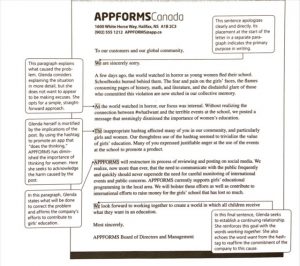4.7 Examples of Maintaining External Relationships in Business Letters
This chapter is adapted from Lean, Ethical Business Communication (2017), by Binod Sundararajan and Linda Macdonald, published by Oxford University Press. Used with permission from the publisher.
Each of the following cases illustrates the challenges of effective business communication. The writers need to assess their audience, clearly understand and then articulate the purpose of the message, and deliver it in a form appropriate for an external audience. These example come from the fictional company APPFORMS, a tech company that develops mobile applications.
The Case of Gary Chambers: Good News Messaging
Gary Chambers works in communications at APPFORMS (a fictional company). The company supports technology in schools through an annual O-Snapp competition in which students are challenged to create an original mobile application aimed at Maritime youth. Gary has been asked to write letters of congratulations to the finalists and invite them to spend a day at the company. During this visit, students will attend seminars on m-commerce (mobile commerce), share their experiences creating apps, and job shadow an APPFORMS employee.
The message is aimed at an external audience, so a letter or an email would be appropriate. Gary decides, however, that the message requires an official format. A business letter adds formality to the document and importance to the students’ accomplishment. Since the day students will be invited to spend at APPFORMS is two months away, the few days required for postal delivery is not an issue. The cost of postage is a worthwhile expense for the community-building that the program provides. Also, Gary knows from his own experience that a letter, so rarely received these days, can have an impact on the sense of accomplishment and pride of a young person.
Gary is a aware that the format, style, and language of the letter reflect the image and reputation of APPFORMS. The student might share the letter with family and friends, and so it could have a broad public relations impact. In addition, the letter establishes a relationship with the student. Gary would like to convey respect for the student by delivering a clear and error-free document and by using language that is accessible to a youthful audience but appropriate for an accomplished and successful emerging professional. Although the letter is a formal channel of communication, he wants to establish a natural, working relationship with the student.
Gary’s message needs to satisfy his purpose, so it should contain the note of congratulations, an explanation of the day at APPFORMS, and a request to accept the invitation to the event by telephone. He knows the message is likely to be read all the way through if:
- it is no longer than one or two pages,
- he begins with the congratulations to gain the reader’s attention and immediately reveal his purpose for writing,
- he personalizes the message to each recipient, and
- he maintains his focus on the needs of his audience.
Gary constructs the following personalized message to the first award-winner on his list. Note that this letter uses a gendered honorific (“Ms.”). Avoid using gendered honorifics if the recipient has not made their gender preferences known.

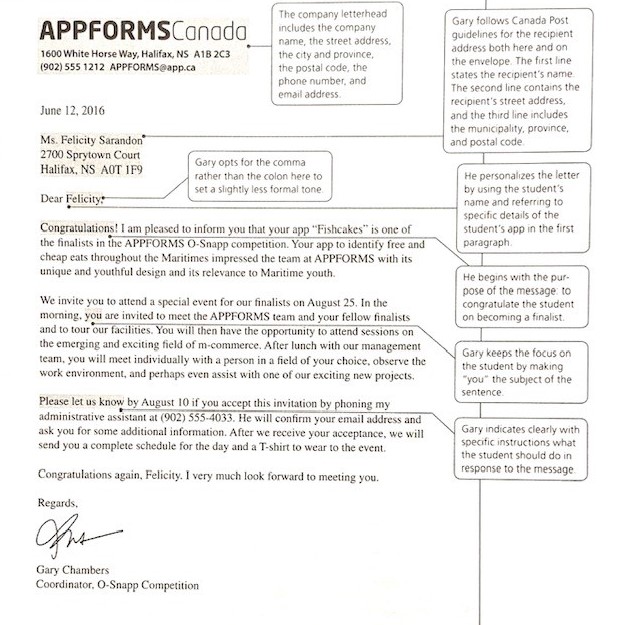
The Case of Hamish Iosepho: Letter of Complaint
Hamish Iosepho works as an administrative assistant at APPFORMS. Last year, the city contracted out snow removal. In January, one of the contractors, Smurfy’s Lawncare and Snow Removal Service, damaged one corner of the APPFORMS building with a small bulldozer. APPFORMS filed a complaint with the city, which forwarded the complaint to the contractor. It is now June, and no repairs have been done. On behalf of APPFORMS, Hamish phones the contractor to complain about the lack of response concerning the damage and to request that the situation be addressed immediately. The contractor’s receptionist said she would check into the problem and respond as soon as possible.
A week later, Hamish received a letter from Smurfy’s in response to his request:
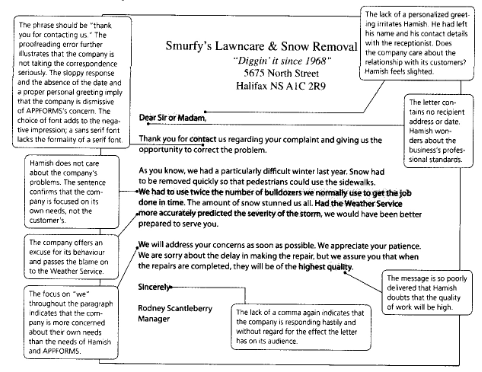
The letter indicates to Hamish that Smurfy’s does not care about the damage they caused. The letter seems to diminish his concern. Irritated by how the company has dismissed his complaint and the inappropriate response, Hamish is more determined than before to seek reparations. He writes to the district’s councilor to voice his complaints.
In writing his complaint, Hamish
- clearly states the purpose of his letter,
- describes the problem,
- explains the impact of the problem,
- states what action should be taken and by when, and
- ends on a positive note to express goodwill.

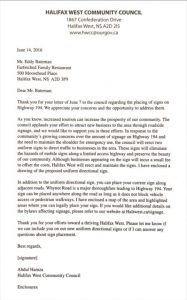
The Case of Abdul Hamza: Bad News Messaging
In addition to his work as a managing partner at APPFORMS, Abdul Hamza serves as a community councilor in the western part of Halifax. In a letter to the editor in this week’s newspaper, a resident and business owner, Eddy Bateman, expressed anger over the city’s request that he remove a sign he had placed along the highway advertising his family restaurant. The sign was professionally designed and painted. Local officials told Eddy that he could not place the sign on a limited-access highway, and it had to be removed immediately. Eddy argued that the request to remove the sign goes against the community’s goal to attract tourism; his sign could bring much needed business to the area. In addition to writing to the newspaper, Eddy wrote a letter to the council and accused them of going too far with regulations.
Abdul seeks to maintain the goodwill of the community member, but he also wants to uphold the community’s standards for roadside signage, which other members of the community regard as visual pollution and as a distraction– and therefore a safety issue– on public highways. In the past, signs were permitted along the highways, but the large number of signs affected the beauty of the landscape, and they cluttered the roadside shoulder intended for emergency use. The community regulations, available online, clearly state that signs are no longer permitted.
The community council supports the removal of the sign, and Abdul is tasked with writing Eddy to inform him that, despite the sign’s professional design and visual appeal, it cannot be placed along the highway. He composes his letter, which focuses on the legal justification of the bad news.

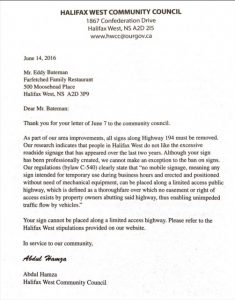
Abdul reviews his letter. He has opened the letter with a positive note of thanks. He then explains the reason for the council’s decision and tells Eddy what actions he needs to take: Eddy should not place the sign along the highway and should review the bylaw.
The letter format is correct. The return address is followed by the date and the recipient’s address. The second paragraph looks a bit long, but Abdul thinks the letter has a sufficient amount of white space.
But he is not satisfied with the letter. It sounds cold and unsympathetic because of the legal language. Even the opening statement of thanks sounds harsh and impersonal. The message is strongly focused on the bad news.
Adbul considers the purpose of his letter. He wants Eddy to accept that he must obey the bylaw, but Abdul also wants to maintain a good relationship with a community member. The opening line is somewhat positive, but he has put a second positive statement (the reference to the professional quality of the sign) in a subordinate clause. This clause is followed be “we cannot.” Abdul does not want to emphasize the negative– what cannot be done. He wants instead to focus on what Eddy can do.
He reviews the situation. Eddy is right that the community council wants to attract tourists to the area to improve the local economy. Abdul appreciates Eddy’s efforts to establish a business consistent with this goal. Eddy’s highway sign is tasteful and professional. He truly appreciates Eddy’s letter since it reveals his interest in and dedication to the community.
Abdul decides to revise his letter to emphasize the mutual goals of both the community council and Eddy and to emphasize the positive aspects of Eddy’s efforts. He wants to be clear that the sign cannot be placed on the highway, but rather than present the legal limitations, he would like to stress the possibilities. He wants to turn the focus away from the bad news of what cannot be done toward the positive of what can be done.
He drafts a new letter.

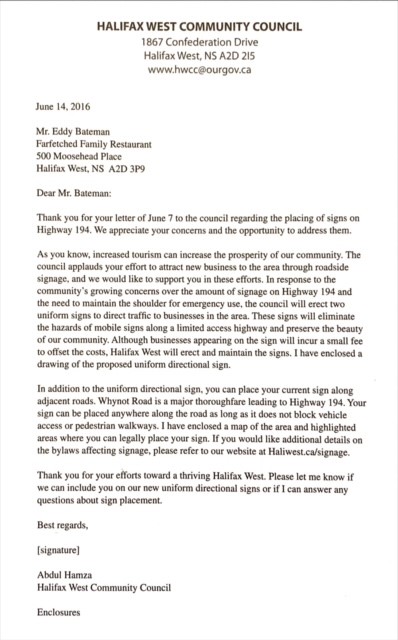
The Case of Glenda Goodwin: Letter of Apology
Glenda Goodwin manages APPFORM’s social media platforms, including a company blog, Instagram, twitter, and Facebook. Along with her team, she manages APPFORM’s social identity, develops approaches for reaching stakeholders through social media, and interacts with customers to maintain an ongoing conversation.
This week has been particularly busy for Glenda. One member of her team had emergency surgery and is now absent, so her department is short-staffed. With the recent launch of a series of android apps, Glenda has felt pressure to increase the number and frequency of social media posts. One of her team members suggested the post “#whatIwant an app that does the thinking for me” as part of a conversation about an app that creates grocery lists from online recipes. Typically, content is proposed by team members, all members of the team review the proposed items, and the message is then posted. Rather than subject the proposed message to a team review, Glenda posted the item.
Within 90 seconds, APPFORMS received 115 responses to the post. Two days previously, a radical group made global headlines when it overtook a girls’ school serving a minority population, burned all of its books, and terrified the students, who were now too afraid to return to school. The hashtag “whatIwant” had been used by various groups to call attention to the need to support girls who want an education but who live in areas where the education of girls is forbidden or unavailable. The hashtag had been used in thousands of posts globally.
Glenda’s team had seen the hashtag but had not verified its original meaning. Much of the team’s energy was being spent on social social media that focused on the release of the new apps, and they had not been monitoring current happenings and trends. Glenda was not aware of the hashtag’s use to support girls’ education, so the proposed hashtag and comment did not raise alarms.
As soon as Glenda received the first responses from outraged stakeholder and members of the public, she investigated the issue. She was horrified to discover the implications of the post. These stakeholders were right; the use of the hashtag at this time was terribly inappropriate, and the reference to wanting an app that “does the thinking” at a time when girls are being denied the opportunity to learn was appalling.
Glenda immediately withdrew the offensive post. She knew she must send an apology as soon as possible. Apologies from organizations are common now that consumers hold organizations to higher standards of social responsibility. Because communication between consumers and businesses is more direct and more frequent through technology, Glenda realizes that her response must be quick, but, to avoid making the situation worse, carefully crafted. She will first send an apology using social media and then write a letter of apology in a press release.
Models of these apologies are everywhere. Glenda starts by doing some online research. She finds an article by Josh Bloch of CBC News entitled “Age of the public apology: How saying sorry has gone pro.” Bloch cites Chris Lehane, author of Masters of Disaster: The Ten Commandments of Damage Control. According to Lehane, Bloch writes, the apology should be delivered soon after the offensive comment has been made. “I’m sorry” should appear early in the message, the message should indicate acceptance of responsibility rather than offer excuses, and the apology should state what actions will be taken and include assurances that the offence will not occur again.
She finds a similar structure outlined by Perfect Apology in “Sample apology letter: An analysis of the JetBlue apology”. The article breaks down JetBlue’s apology for poor customer service following a severe winter storm that caused travel delays. The airline’s apology began with “We are sorry and embarrassed. But most of all, we are deeply sorry.” This beginning satisfies Lehane’s suggestion to say “I’m sorry” early in the message. As the Perfect Apology article points out, the second paragraph of of JetBlue’s apology explains what happened in the incident without casting blame elsewhere, even on the weather. The letter goes on to acknowledge the harm that the incident caused customers. JetBlue then outlines the measures to be taken to ensure a similar problem does not occur in the future. The airline’s desire to repair and maintain its relationship with customers is evident in the offer of compensation and the statement, “Nothing is more important than regaining your trust, and all of us here hope you will give us the opportunity to welcome you onboard again soon and provide you the positive JetBlue experience you have come to expect form us.”
Glenda extracts from these sources her structure for the apology”:
- a direct apology
- an explanation of how and why the problem occurred,
- an acknowledgment of the hurt or dissatisfaction of stakeholders,
- the efforts to correct the problem, and
- a desire to continue the relationship.

